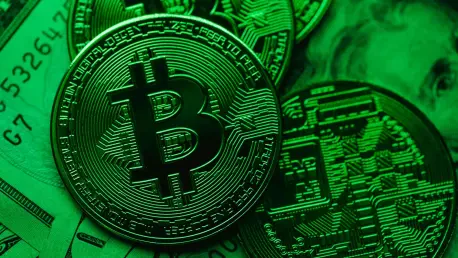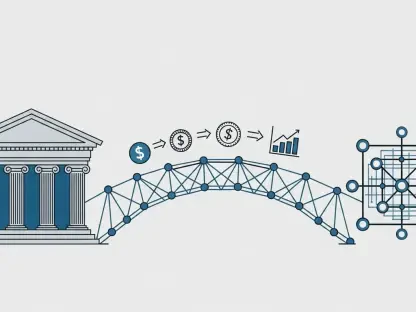In a seismic shift that has reverberated across the cryptocurrency landscape, OKX, a titan among global crypto exchanges, has undertaken an extraordinary measure by burning 65.26 million of its native OKB tokens, valued at a staggering $7.6 billion, effectively halving the token’s total supply to a capped 21 million. This audacious move, echoing Bitcoin’s scarcity-driven model, stands as one of the most significant token burns in the history of exchange tokens. Designed to create a sense of rarity and potentially elevate the token’s market value, this event has not only captured the attention of traders and industry analysts but also sparked intense discussions about the future of tokenomics. The immediate aftermath saw OKB’s price surge dramatically from $46 to a peak of $142, before stabilizing near $102, while trading volume exploded by an unprecedented 13,000% to $723 million. Such a bold strategy underscores the growing trend among exchanges to manipulate supply as a means of influencing market dynamics, raising critical questions about the sustainability of these tactics. As the dust begins to settle, the crypto community is left to ponder the long-term implications of this historic burn on OKX’s ecosystem and the broader digital asset market.
Unpacking the Scale and Strategy of the Burn
The sheer magnitude of OKX’s token burn sets it apart as a landmark event in the cryptocurrency sector. By removing over 65 million OKB tokens from circulation, valued at approximately $7.6 billion, the exchange has not only slashed its supply by half but also positioned OKB as a token with a finite cap of 21 million, reminiscent of Bitcoin’s hard limit. This deflationary tactic is rooted in the principle of scarcity, aiming to drive up value by reducing availability. Announced with little prior fanfare, the burn was executed swiftly, catching many in the market off guard and amplifying its impact. The strategic intent appears clear: to bolster investor confidence and create a surge in demand for the remaining tokens. This move places OKX among a select group of exchanges employing aggressive tokenomics to shape market perception, highlighting a calculated effort to stand out in an increasingly competitive landscape. While the immediate financial implications are evident, the broader effects on user trust and platform engagement remain under scrutiny as the industry watches closely.
Equally striking is the market’s rapid response to this unprecedented reduction in supply. Within mere hours of the announcement, OKB’s price catapulted from a modest $46 to an astonishing high of $142, reflecting a frenzy of buying activity as investors rushed to capitalize on the perceived scarcity. Although the price later moderated to around $102, the trading volume told an even more dramatic story, skyrocketing by 13,000% to reach $723 million. This surge in activity underscores the potency of supply-side interventions in volatile markets, where sentiment can shift dramatically based on structural changes. However, it also raises concerns about speculative bubbles, as such sharp price movements may not always align with intrinsic value. For OKX, the challenge lies in translating this short-term excitement into sustained growth, ensuring that the token’s utility within its ecosystem matches the heightened market enthusiasm triggered by the burn.
Tokenomics as a Market-Shaping Tool
Delving into the mechanics of tokenomics, OKX’s decision to halve its OKB supply mirrors a broader trend among leading exchanges to leverage supply manipulation as a competitive strategy. Similar to Binance’s periodic burns of its BNB token, this approach seeks to create a perception of value through reduced availability, often resulting in immediate price spikes and heightened investor interest. By aligning OKB’s supply cap with Bitcoin’s iconic 21 million limit, OKX taps into a narrative of digital scarcity that resonates deeply with crypto enthusiasts. This burn reflects a deliberate attempt to position the token as a premium asset within the exchange’s ecosystem, potentially enhancing its appeal for both trading and long-term holding. Yet, the effectiveness of such strategies hinges on more than just supply cuts; it requires a robust framework of utility and adoption to maintain relevance beyond the initial hype.
While the short-term market impact of the burn is undeniable, with significant price and volume increases, the long-term ramifications for OKB remain uncertain. Token burns can serve as powerful catalysts for market sentiment, but they often lack the depth to sustain value without accompanying enhancements in functionality. For OKX, the burn represents a gamble that investor excitement will translate into deeper engagement with its platform, whether through trading, staking, or other services tied to OKB. Analysts note that while deflationary measures can attract attention, they risk being seen as mere publicity stunts if not paired with tangible improvements in the token’s role within the exchange. As such, the coming months will be critical in assessing whether this bold move can evolve from a momentary spike to a cornerstone of OKX’s growth strategy in a crowded market.
Industry Context and Competitive Dynamics
OKX’s token burn does not exist in isolation but rather as part of a wider wave of economic experimentation sweeping through the cryptocurrency industry. Exchanges are increasingly turning to token burns and other supply-side mechanisms to differentiate themselves in a saturated market, where user loyalty and investor trust are hard-won commodities. By halving OKB’s supply, OKX not only draws parallels to Bitcoin’s scarcity model but also signals a shift toward aligning native tokens with broader narratives of value preservation. This strategy echoes moves by competitors who have similarly used burns to bolster their tokens’ profiles, creating a ripple effect across the sector. The event highlights how tokenomics has become a battleground for exchanges seeking to capture market share, with each burn or policy shift serving as a statement of intent in an evolving landscape.
However, this trend also exposes the speculative undercurrents that define much of the crypto market. While OKX’s burn triggered a remarkable price surge, it prompts debate over whether such actions genuinely enhance a token’s fundamental value or merely fuel short-lived hype. Critics argue that without a clear roadmap for increasing OKB’s utility—be it through expanded use cases or deeper integration into OKX’s services—the burn risks being perceived as a superficial maneuver. As other exchanges observe the fallout, there is potential for a domino effect, with similar supply reductions becoming a standard playbook for boosting visibility. The industry now stands at a crossroads, balancing the allure of quick market gains against the need for sustainable development that can anchor tokens like OKB in lasting relevance.
Investor Opportunities and Risks
For investors, the OKX token burn presents a complex mix of opportunity and uncertainty that demands careful navigation. The dramatic price jump from $46 to a peak of $142 offered a window for substantial short-term profits, drawing in traders eager to ride the wave of market enthusiasm. Yet, with the price stabilizing around $102, there is a palpable sense of caution against over-optimism, as rapid gains often precede corrections in volatile markets. Seasoned investors are closely monitoring OKX’s subsequent actions, particularly efforts to enhance OKB’s role within its platform, as a gauge of whether further upside is feasible. The burn has undeniably heightened OKB’s visibility, but it also amplifies the stakes for those betting on its trajectory, requiring a balanced assessment of hype versus underlying value.
Beyond the immediate financial implications, the burn introduces a layer of risk that investors must weigh. Sudden supply shocks, while often beneficial in the short run, can lead to heightened volatility, making price predictions challenging even for experienced traders. The staggering 13,000% increase in trading volume to $723 million reflects intense market interest, but it also signals potential instability as speculative trading dominates. Investors are advised to consider the broader context of OKX’s ecosystem, evaluating whether the reduced supply will translate into meaningful benefits like lower fees or enhanced rewards. As the market digests this event, the focus shifts to whether OKX can sustain investor confidence by delivering on promises of utility, ensuring that OKB remains a compelling asset amid fluctuating sentiment.
User Implications and Platform Evolution
For regular users of the OKX platform, the token burn carries implications that extend beyond market charts into everyday interactions with the exchange. With OKB’s supply now halved, there is potential for the token to gain prominence as a medium for transaction fees, staking rewards, or other platform-specific benefits. A reduced supply could enhance its appeal as a scarce asset, encouraging users to hold or utilize OKB more actively within the ecosystem. This shift might also prompt OKX to roll out new features or incentives tied to the token, aiming to deepen user engagement. However, users should remain vigilant about how these changes align with their expectations, as the burn’s impact on practical utility is yet to fully materialize in day-to-day operations.
Additionally, the burn places pressure on OKX to ensure that the token’s newfound scarcity translates into tangible value for its community. Users may anticipate adjustments in how OKB functions within the platform, potentially affecting cost structures or reward mechanisms. While the market’s reaction has been overwhelmingly positive, the onus is on OKX to communicate clearly how this supply reduction benefits its user base beyond speculative price gains. Failure to integrate OKB more meaningfully into its services could lead to disillusionment among users who view the burn as a detached financial maneuver. As the exchange navigates this transition, user feedback and adoption rates will serve as critical indicators of whether the burn strengthens OKX’s position as a user-centric platform in a competitive field.
Future Pathways and Industry Influence
Reflecting on the aftermath of this monumental token burn, the spotlight remains firmly on OKX to prove that this was more than a fleeting spectacle. The exchange’s ability to weave OKB deeper into its operational fabric—through expanded use cases, strategic partnerships, or enhanced incentives—will determine whether the value created by this supply cut endures. Industry observers are keenly watching for signs of innovation that could cement OKB’s status as a cornerstone of OKX’s offerings, potentially setting a benchmark for how token burns can drive meaningful growth. If successful, this move could inspire a wave of similar strategies across the sector, reshaping how exchanges approach tokenomics as a tool for long-term sustainability.
Moreover, the OKX burn serves as a potent reminder of the unpredictable dynamism that defines the cryptocurrency realm. It illustrates how a single, well-executed decision can send ripples through global markets, altering investor behavior and reframing perceptions of token value in an instant. As the industry digests this event, it becomes clear that such actions carry the power to influence broader trends, pushing competitors to rethink their approaches to supply management. Looking forward, the crypto community anticipates further evolution in how exchanges balance short-term market maneuvers with the imperative of building robust, utility-driven ecosystems. The legacy of this burn will likely resonate in future discussions on innovation and strategy within the ever-shifting digital asset landscape.









